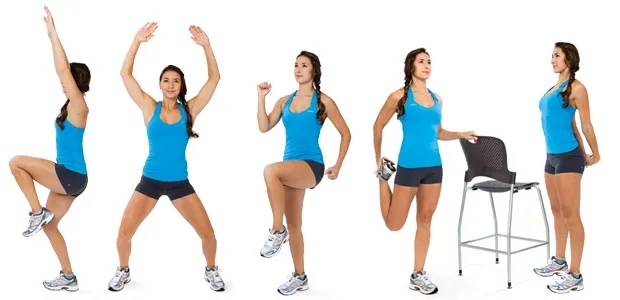HELLO STEEMERS. LETS #LEARNSOMETHINGNEW
People usually wonder about these questions -
Why do people need to warm up before exercise? Many animals don’t seem to have such an issue, like a cat going from completely still to sprinting after prey. So what exactly is going on internally that makes doing some activity with a warm up first less injury prone than if one just jumps into it? Or is it just a myth that we should warm up and it doesn’t actually do anything?

What is Warming up consists of?
A warm up generally consists of a gradual increase in intensity in physical activity (a "pulse raiser"), joint mobility exercise, and stretching, followed by the activity. ... It is important that warm ups be specific to the activity, so that the muscles to be used are activated.

There isn't a respectable fitness coach in any game that doesn't stretch the significance of warming up before you start an exercise or athletic attempt. The vast majority appear to know you can anticipate wounds and take into account better execution should you take after their recommendation. Things being what they are, shouldn't something be said about warming up takes into account these advantages? What precisely is going ahead in the body when you all the more gradually set it up for strenuous movement, as opposed to simply bouncing directly into it?

The basic answer is that warming up expands blood stream to muscles, taking into account a hoisted measure of oxygen and supplements to be conveyed. This readies the muscles for an ascent in workload. Warming up will likewise start raising body temperature, which causes you use oxygen better. That lift in blood stream likewise serves to take action providing your muscles with driving forces, expanding the nature of execution.

Alongside the blood stream and temperature benefits, a fitting warmup additionally counteracts wounds by giving more prominent scope of movement, while all the while enhancing the grease of joints, taking into consideration better development. Ultimately, numerous mentors place that a decent warm-up before any occasion where execution is esteemed can help rationally set you up for the undertaking to come.
So that is the abnormal state perspective of everything. In any case, what really is going on inside here?
Initially, how about we take a gander at what gives your body the capacity to convey more oxygen. It appears to be sound judgment that if the normal heart rate is around 70 thumps for each moment, and each beat discharges roughly 70 ml of blood, at that point your heart will circle around 4.9 liters consistently. The higher the heart rate, the more blood will be pumped. Amid extraordinary exercise, examines have demonstrated your heart can pump up to 30 liters for each moment! The inquiry at that point progresses toward becoming why does gradually expanding heart rate, and by expansion blood stream, versus all of a sudden jumping energetically and quickly expanding blood stream take into account better execution, while diminishing damage?

When your muscles are working harder than normal, they require more oxygen and nutrients. This provides all the electrolytes responsible for the electrical impulses providing for muscle contraction and glucose to start a cascade of chemical events leading to the production of a molecule called Adenosine Triphosphate (ATP). ATP is responsible for moving those electrolytes (and other molecules) in to, out of, and around your cells. Oxygen is also essential in creating ATP.
When oxygen is used to create ATP, it’s called aerobic metabolism. When you increase the work of your muscles past the point oxygen can make the appropriate amount of ATP, your cells begin to use glucose and acids to make more, also known as anaerobic metabolism.
The byproduct of anaerobic metabolism is the increased production of an acid called pyruvate, which also creates lactic acid. Those acids will cause all kinds of damage to your cells. The resulting pain that follows leaves every marathon runner in agony the next day. The maximum heart rate at which your cells can use oxygen to make ATP is known as your Vo2max.

What does all this chemistry have to do with warming up?
Studies have reliably demonstrated that your Vo2 max is expanded when you warm up gradually. This is on the grounds that the numerous little vessels that supply your cells are shut while resting. Should you open them up, they'll be more ready to give the additional oxygen and supplements to the working cells. In this way, warming up will make those resting vessels open up. Along these lines, when the occasion begins, and you truly require them, they'll as of now have the capacity to deal with a higher Vo2max, and you show signs of improvement execution.
For instance, in one investigation, individuals were subjected to run at most extreme exertion for 10-15 seconds without warming up. 70% of them had irregular ECG discoveries (the electrical driving forces furnishing your heart with its required withdrawal). Those anomalies were credited to lacking blood supply to the heart (anaerobic digestion). Those influenced 70% of members were then permitted to warm up for only 2 minutes preceding run, again for 10-15 seconds. That little of a warm up was sufficient to lessen the ECG variations from the norm by 90%!
Another way your body gets the benefit of more oxygen is by raising its temperature and making your cells more acidic. An increase in your body’s temperature will support faster muscle contraction and relaxation, as well as a boost to nerve impulses and raise the metabolism of cells. One of the mechanisms for these results revolves around how your body carries that oxygen.
The molecule within your blood responsible for circulating oxygen is called hemoglobin, which attaches and subsequently releases oxygen thanks to the affinity hemoglobin has for oxygen.

To save you a protracted specialized dialog of how that all functions, I'll simply say that, more or less, every hemoglobin particle can convey four oxygen atoms. That doesn't really mean it will convey four, yet it can. The measure of oxygen it carries is called oxygen immersion. The more oxygen around the hemoglobin, as on account of hemoglobin presented to the air in your lungs, the more soaked it will move toward becoming. In conditions where there is less oxygen present, as on account of cells that are encountering anaerobic digestion, hemoglobin will discharge the oxygen. That free oxygen is then promptly accessible for your cells to use to make ATP.
At higher body temperatures, and more acidic conditions, hemoglobin will discharge more oxygen contrasted with bring down temperatures, and less acidic situations. Should you warm up, your expanded body temperature and the somewhat higher acidic condition inside your cells will make your hemoglobin discharge more oxygen. The outcome expands your cells' capacity to make more ATP utilizing oxygen and giving you the upper hand of an expanded Vo2max. These outcomes are known as The Bohr impact.
Subsequently, expanded blood stream, joined with the more prominent oxygen digestion, represents a few of the known advantages to warming up-specifically, the execution upgrade given by the expanded Vo2max, and the preparing of the nerves providing your muscles with their vital driving forces.
Now on to injury prevention.
It’s widely known that warming up will prevent muscle injury, specifically, preventing painful tears and strains. No study to date has definitively shown the exact mechanisms causing the damage. Get a group of people to subject themselves to a study administering muscle stress so great it will tear them while a team of researchers monitors everything going on internally and you might be able provide some detailed insight…
Until then, the leading theory is that “cold” muscles are less elastic and shorter than those that aren’t. Along with the muscles, your ligaments and tendons also shorten up when not particularly used. Should you subject your shortened and stiff muscles, tendons, and ligaments to the force required for strenuous activity, they may snap or tear, somewhat analogous to how a cold rubber band will snap quicker than a warm one when stretched. So, warm up, then stretch appropriately, and your rubber-band-muscles will be able to better elongate like Gumby in a yoga class, thus helping to prevent injury.
As the theory on injury prevention goes, your joints will also begin to become more lubricated during warm up, allowing for greater range of motion (ROM). This is because the production of fluid that brings oxygen and nutrients into the joints, while also providing lubrication (synovial fluid), is increased during exercise. So, warm up, and your joints will also be better able to handle the stress and the increased ROM needed for athletic performance.
Cheers :)
